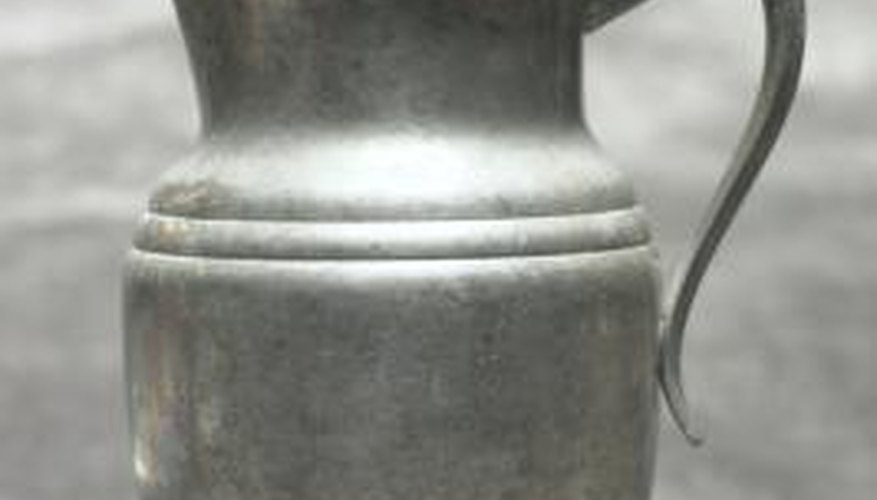Pewter has been used for centuries to produce tableware, cookware, candlesticks, decorative and religious items, and jewellery. Pewter was primarily used in churches during medieval times, but it eventually found its way into wealthy merchant class homes, where it replaced wooden plates and utensils. Pewter remained popular with the wealthy until the middle of the 18th century, when its supplanted by porcelain and other glass. Today pewter is still used for decorative items, collectibles and jewellery.
Composition of Pewter
Pewter is an alloy. A metal alloy is produced by combining a metal with two or more elements that enhance the properties of the metal. Modern pewter is an alloy comprised primarily of the following elements: tin, antimony and copper.
Pewter is at least 90 per cent tin. Tin is an extremely soft metal, and alloying tin with other metals allows makes it practical for metalworking and daily use. Antimony hardens the tin so it will not crack or split when it is hammered or formed. Modern pewter contains as little as 0.5 per cent and as much as 8.0 per cent antimony. Copper makes the finished alloy more malleable and ductile. Higher amounts of copper lend a gold tint to the pewter. Modern pewter contains up to 2.5 per cent copper.
- A metal alloy is produced by combining a metal with two or more elements that enhance the properties of the metal.
- Modern pewter contains up to 2.5 per cent copper.
Pewter made before 1930 may also contain lead. Pewter containing lead has a bluish colour. Lead was discontinued as a component of pewter as its harmful effects became known.
Malleabilty and Casting
Pewter is known for its malleability and ductility. This means pewter is easily bent or hammered into other shapes without breaking, splitting or cracking. Pewter's malleability allows it to be crafted into shapes by several methods including forming, fabrication and being hammered into moulds. Most pewter pieces were produced by casting until the early 19th century. Casting is the process of forming things in a mould. Pewter is cast by pouring molten pewter into a shaped mould. Molds for casting pewter were typically made of bronze or brass. Modern moulds may be made of vulcanised rubber.
- Pewter is known for its malleability and ductility.
- Pewter's malleability allows it to be crafted into shapes by several methods including forming, fabrication and being hammered into moulds.
Low Melting Point
Pewter's low melting temperature made it a good casting metal. The melting temperature depends upon the proportions of tin, antimony and copper in its composition, but pewter typically melts in a temperature range of 176 to 232 degrees C. Due to its low melting temperature, do not place pewter objects on an oven or stove or near any other open source of heat.
Vulnerabilities
Pewter is vulnerable to damage by acidic substances. Exposure to salad dressings, citrus juices and dips should be limited, and pewter should be washed immediately after exposure with warm soapy water. As a soft metal, pewter is easily scratched or dented. Take care when cutting or chopping on pewter so as not to damage the metal. If pewter is scratched, it may be restored by gentle rubbing with a fine-grade steel wool. Pewter may also be damaged or dented by careless or rough handling, being dropped, exposure to high heat, and use in automatic dishwashers.
Old pewter will tarnish over time, but modern pewter should be reasonably free from tarnish problems.
- Pewter is vulnerable to damage by acidic substances.
- Old pewter will tarnish over time, but modern pewter should be reasonably free from tarnish problems.
